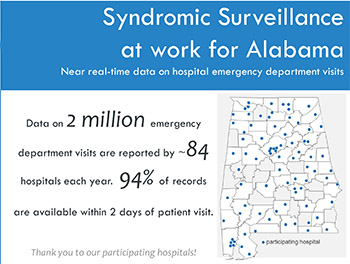Syndromic Surveillance
The United States Centers for Disease Control and Prevention (CDC) describes syndromic surveillance (SyS) as the practice of using data and statistical tools to detect, monitor, and characterize unusual activity for further public health investigation or response. Syndromic data may include information on patients seeking treatment at emergency, urgent care, ambulatory care, and inpatient healthcare settings. Some jurisdictions may also utilize information from other sources like poison centers, pharmacies, schools, and social media.
Since data collection occurs prior to a physician diagnosis or laboratory result, a symptom complex or syndrome is determined using information available for each encounter and complex computer algorithms. In other words, syndrome classifications are pre-diagnostic. Public health monitors syndromic data in near real-time because it may present an emergent picture of community-level health events. Pre-diagnostic recognition of events, disease, and outbreaks can lead to early public health intervention.

About Syndromic Surveillance in Alabama (AlaSyS)
The Alabama Department of Public Health (ADPH) collects and monitors data on emergency department visits to inform public health interventions and data on more than two million emergency department visits reported by ~85 hospitals each year. Each record includes de-identified information on the patient and their chief complaint. Ninety-four percent of records are available within two days of patient visit. See our printable overview of ADPH syndromic surveillance activities, including examples of how data are used and AlaSyS contact information.
Please note: Syndromic surveillance does not replace required reporting for specific notifiable diseases and conditions described in more detail here.
Learn More About AlaSys
Contact AlaSyS
Questions and comments about ADPH syndromic surveillance activities can be emailed to [email protected] or you can contact us by phone Monday through Friday 8:00 a.m. to 4:30 p.m. by calling 334-206-5971.
District Epi's Internal Website to check BioSense Platform – Daily Site Processing Summary for AL
Page last updated: May 17, 2024




